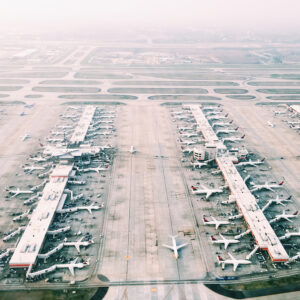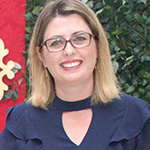By Tessaleno Devezas, Professor, researcher, Atlântica School of Management Sciences, Health, IT & Engineering, Barcarena, Lisboa e C-MAST (Center for Aerospace Science and Technologies – Fundação de Ciência e Tecnologia, Portugal; Viviane Gonçalves, Master in Information Science, Sorocaba, SP, Brazil

Image: Skyler Smith.
Given the COVID-19 pandemic that hit the world in late 2019 and early 2020, it can be said that all sectors of human activities were affected. The economic and social depression that has set in will change the course of history and present several challenges for humanity. We are experiencing a “new normal” that counts thousands of deaths and uncertainties on how to get out of this situation.
In order to expand the discussion on the effects of the pandemic in the airline industry, I interviewed Professor Tessaleno Devezas, physicist, systems theorist and materials scientist, known for his contributions to the theory of long waves in socioeconomic development, technological evolution, energy systems, as well as in the analysis of world systems. In the editorial “Aeronautics and COVID-19: a reciprocal cause-and-effect phenomenon”, published in the Journal of Aerospace Technology and Management (vol. 12), the author presents how the aeronautical sector was affected by the pandemic of COVID-19 and what are the possible short, medium and long-term scenarios for change and recovery.
1. How was the airline industry involved in the beginning of the COVID-19 pandemic?
In my opinion, the ‘surprise effect’ was due to the simultaneous action of two agents: the excess of global physical connectivity due to the whole set of transport systems (but with an emphasis on aviation due to the speed with which it speeds the movement of people across the planet) , and new properties of the SARS-CoV2 virus (highlighting its longer incubation time). This joint action of the two agents acted in a catastrophic way on the overly globalized and connected socioeconomic system, revealing its already anticipated fragility.
2. The airline industry was one of the most impacted by the pandemic. How intense was the reduction in this line of business?
The fact that, while on the one hand the aeronautical sector can be blamed for the rapid spread of the pandemic, on the other hand it was one of the sectors of human activity hardest hit by it. Air traffic intensity was reduced in 2020 by almost 60% of the total passengers transported in 2019 (see figure below), not counting the cargo transport sector. The effect that has been verified of mass layoffs and bankruptcies by airliners, the cancellation of orders in the aeronautical production sector, among others, is notorious.
3. What to expect from the airline industry after the passing of the COVID-19 pandemic?
I worked with the hypothesis of three possible scenarios, which I like to call the good, the bad, and the ugly. I explain: the good would be the one in which we would have a full recovery up to the level of demand prior to the crisis, which I believe is very unlikely. The most pessimistic, the ugly, considers a long period of depression, similar to that of the 1930s, as is being anticipated by some economists, and still exacerbated by the growing geopolitical tensions between the US (with some allies) and Russia-China- Iran. I do not sincerely believe in such a negative scenario; we now have very different and more efficient economic measures than at that time. The realist, which I call bad because it brings with it many traces of the negative impact of the economic shock, but, on the other hand, is also a little optimistic about the necessary reorganization of institutions and a renewed attitude of people towards their social behavior. It is actually what has been called the “new normal”.
4. In this realistic scenario, how do you imagine the aeronautics market and its global size will be?
In my view, the minimum period for the recovery of the sector should be between two and six years. My projections for 2021 indicate the hypothesis of a recovery of about 75% of the (previous) level of passengers transported. We must also consider some important aspects of the “new normal” that will affect the aeronautical sector: health concerns and the spread of epidemics certainly may act as a mechanism to slow down the movement of people on flights. Furthermore, many companies and businesspeople are now aware that remote work can be done and contribute to the optimization of their business. I believe that in the immediate future, there should also be some increase in air ticket prices as a result of competition between airliners and the need to apply the necessary social distance measures. Companies should also consider the size and typology of their fleets. It is very likely that ‘wide bodies’ airplanes will become obsolete.
5. Given what has been presented, can it be said that we can learn a lesson from all this and reinvent ourselves to face other crises?
For now, I would highlight an important aspect, if you want to take effective measures to cope with future epidemics and adjust air transport according to the requirements of the ‘new normal’ that has been installed. My advice is: look to the East!! See that the region of the world most affected by the pandemic was the highly developed West: the USA and Europe. They did not know how to deal with the pandemic. Now look to the East and think about the cases of Singapore, Vietnam, South Korea, Cambodia, Japan, not to mention China. If you really want to work on the necessary adjustments for aeronautical transport, try to see what is being done on that side of the world: they are coming out of the crisis and they are flying!
References
DEVEZAS, T. From my perspective: The Struggle SARS-CoV-2 vs. Homo Sapiens – Why the Earth Stood Still, and How Will It Keep Moving On?. Technological Forecasting & Social Change [online], 2020. In press.
DEVEZAS, T. Tends in aviation: Rebound effect and the struggle composites vs aluminum. Technological Forecasting & Social Change [online], 2020. In press.
To read the article, access it
DEVEZAS, T. Aeronautics and COVID-19: a reciprocal cause-and-effect phenomenon. J. Aerosp. Technol. Manag. [online]. 2020, vol. 12, e3420. ISSN: 2175-9146 [viewed 11 August 2020]. DOI: 10.5028/jatm.v12.1183. Available from: http://ref.scielo.org/4vfms7
External link
Journal of Aerospace Technology and Management – JATM: <http://www.scielo.br/jatm>
About Tessaleno Devezas
Ph.D. in Materials Engineering, Institut für Werkstoffwissenschaften der Friedrich- Alexander Universität Erlangen-Nürnberg, Erlangen, Germany. Associate Professor at Atlântica, School of Management Sciences, Health, IT & Engineering and member of the Research Unity nº 151 C-MAST (Centre for Mechanical and Aerospace Science and Technologies – Portuguese Science and Technology Foundation – FCT). Main research interests: materials engineering, echnological forecasting, futures studies, socioeconomic long waves, evolutionary economics, technological evolution, innovation theory and dynamics, complex adaptive systems and new materials.
About Viviane Gonçalves
Master degree in Science, Management and Information Technology at the Universidade Federal do Paraná – UFPR (2011). She is experienced in editorial production and in the area of Information Science/ Education, working in the following areas: coordination of university publishing, bibliographic databases, scientific journals, information retrieval processes, editorial production, normalization of originals for publishing. Currently, acting as a publishing services consultant.
Como citar este post [ISO 690/2010]:



















Recent Comments